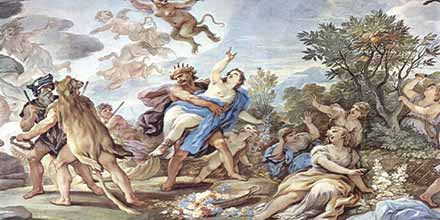Legend of the Rape of Proserpina

The abduction of Proserpina took place at Pergusa Lake and is one of the most famous myths of the Sicilian tradition.
The myth tells that at the beginning of time, the sun always shone on earth and it was always hot. It was the Goddess Ceres who sowed, watered the plants and made the trees bloom and bear fruit. While Ceres worked, her daughter Proserpina played in the green woods of Sicily and in the evening they returned home together singing and laughing. Among the Gods, however, there was a God who was not so happy and fortunate. It was Pluto, the God of the dead, who did not live together with all the other gods on Mount Olympus, but reigned underground, in the cold and in the dark. Occasionally Pluto would rise to the surface to spy on life on earth. One day Pluto spotted Proserpina while she was gathering flowers on the banks of the Lake Pergusa . When he saw her he fell in love with her, but knowing that if he went to ask Ceres to marry her, both would refuse her proposal, he decided to kidnap her, with the consent of Jupiter. When they reached the Acheron River, which divides the kingdom of the living from the kingdom of the dead, Proserpina cried out to the point that even the river took pity, and tried to bring down Pluto by grabbing him by the legs. But Pluto kicked hard and broke free and Proserpina, desperate, took off the belt of flowers that she had in her lap and threw it into the river, so that the waters could carry her message to her mother. Ceres desperately looked for her daughter around the world and in the meantime, out of pain and desperation, she let the flowers wither and stopped sowing so that the wheat and the fruits stopped growing. After nine days and nights spent without sleep and without food in search of her missing daughter, on the tenth day Ceres sat tired and desperate along the bank of a river until she saw a small belt of flowers next to her. The truth was told to her by Elios, the sun god, who illuminates the earth and with his light unveils every dark plot, who revealed to Ceres that everything had happened with the consent of Jupiter. For the pain, Ceres no longer cared for the land and therefore the fertility of the fields ceased and the times of famine and death came. Jupiter, seeing hunger exterminate entire populations, sent his messengers to appease the indignant Ceres, who, adamant in her pain, replied that she would return to the care of the earth only if Proserpina returned. So Jupiter decided to immediately send Mercury to warn his daughter not to touch food, but Mercury, however fast, arrived too late. In fact, Pluto had a succulent and appetizing lunch prepared and even if Proserpina was too unhappy to eat, by dint of insisting, she succumbed to hunger in front of red and juicy pomegranate grains, which Pluto, cunningly, had placed in her hand. Pluto handed him a dozen and, when Mercury arrived, Proserpina unfortunately had already tasted six. The girl burst into tears when she learned of the divine law that he who eats even a single bite while in the kingdom of the dead can no longer return to earth. Proserpina then screamed all her anger and hatred at Pluto for the deception she suffered and Pluto, who was in love with her and would have liked to be loved in turn, turned pale, confessing to having kidnapped her because he felt too alone. Then Jupiter, moved with compassion, decided that Proserpina, having eaten six pomegranate grains, would live in the kingdom of the dead together with Pluto for six months a year and the remaining six months she would live on earth with her mother Ceres.
The myth of Proserpina therefore wants that the arrival of Spring is sanctioned by the arrival of Proserpina on earth, who brings with her the creative breath of abundance and that her return to Hades, six months later, coincides with the arrival autumn and winter, to come back and be reborn again, together with the vegetation, the following spring.
The story of the Roman goddess Proserpina is so suggestive and imbued with charm that it has inspired many artists who, over the centuries, have interpreted the myth using different forms of art. An example is Proserpina fountain in Catania.